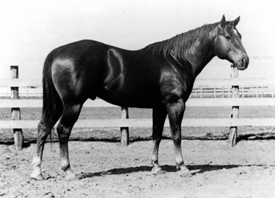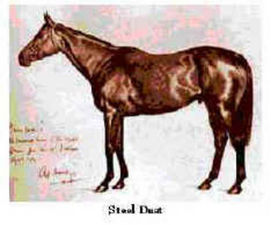The all-American Quarter Horse: a breed with a 'melting pot' heritage

Wimpy (1937-1959) first horse registered to The American Quarter Horse Association.
King Ranch Quarter Horse
It isn’t a surprise the Quarter Horse is the most popular horse in Michigan, because it’s the most popular breed of horse in the United States. The American Quarter Horse Association (AQHA), founded in 1940, has registered more than 5 million horses world-wide since then.
While Quarter Horses are associated with cattle ranches and cowboys, the breed’s beginnings are actually found back east. And as you would expect from a breed developed in America, their origins are a true melting pot.
When the Spanish came to the New World, they brought horses knows as Spanish Barbs, Jennets and other Iberian horse breeds. These compact muscular horses were good for short bursts of speed. English settlers brought their native horses, including Thoroughbreds. Every registered Quarter Horse traces its ancestry back the English-imported, American Thoroughbred stallion, Janus, direct son of the Gololphin Arabian. A hearty, all-around breed arose from the cross of these two strains.
The East became more civilized, and the Thoroughbred became the favored horse of the gentry and for racing. The small, fast sprinters were relegated to common folk and informal races down a town’s main street: fastest horse at a quarter of a mile.
If the gentry didn’t appreciate these horses, early explorers certainly did. Small, tough and hardy, these horses could handle whatever terrain and conditions they faced. Also importantly, they didn’t need expensive hay or grain; they could live on forage they found along the way.
As the population moved west, these animals also moved toward their ultimate destiny. The perfect cow horse had been developed unintentionally.
Embraced by cowboys and ranchers, the breed gained its first unofficial name from one stallion — Steel Dust. Born in 1843 in Kentucky, Steel Dust came to Texas in 1844. He fathered many foals, which all shared several characteristics — muscular, small ears, big jaw, intelligent and amazing speed over short distances. Long known as a favorite type of horse, they were now called “Steeldusts.”

Legendary Quarter Horse Steel Dust (1843-1864), sired by Big Nance (thoroughbred) out of Harry Bluff (half thoroughbred), who was herself sired by Big Nance.
Historical photo of Steel Dust
These horses were being selected and bred for speed and quickness. In 1940, a group of people dedicated to formalizing and improving this breed established the American Quarter Horse Association. The first horse registered, with the number P-1, was Wimpy.
Often the first step after establishing a breed, is “improving” it. And the same is true for Quarter Horses. In this case, improvements have led to several sub-registries.
From its very beginning, the AQHA allowed Thoroughbred blood to be introduced into the Quarter Horse breed. Three Bars, a Thoroughbred stallion, was an early influence in the breed, fathering 29 AQHA Champions and four AQHA Supreme Champions.
For example, the offspring of a registered Quarter Horse and Thoroughbred can be entered into the “appendix” of the AQHA registry. These appendix-registered animals are eligible to compete against any full-blooded Quarter Horse. Additionally, if they meet certain conformation criteria and are successful in AQHA competitions, they can move into the permanent registry. Once that takes place, they and any of their offspring are no different than an animal with no Thoroughbred in its bloodlines.
Over time, several groups felt this practice was diluting the characteristics that distinguished the first Quarter Horses. “Appendix” horses were taller, less heavily muscled, and some would argue, not as hardy.
In an effort to maintain the original breed, “Foundation” Quarter Horse registries were established. These include the Foundation Quarter Horse Association, the National Foundation Quarter Horse Association, and the Hancock Horse Breeders Association.
These registries look to see if a horse has any Thoroughbred in its background. Typically, they require an animal to be at least 90 percent pure Quarter Horse to be eligible for registration. Interestingly enough, these horses are almost always double-registered - AQHA and Foundation registry.
To make things even more interesting, a horse could be registered with a color association, such as the Buckskin Horse Association or the Palomino Horse Breeders Association, enabling it to be triple registered.
What makes this the most widely-found horse in our country? Fans of the Quarter Horse would point to its versatility, intelligence and adaptability. They are known for being level headed — the Golden Retrievers of the horse world.
The answer may lie in what marked the Quarter Horse from the beginning — being a common, well-rounded horse. Most horse owners or riders don’t consider themselves to be affluent, and indeed many are not. A national survey conducted in 2005 found that 34 percwent of horse owners have an income of less than $50,000.
What better for a hard-working owner than a hard-working horse?
This article was written by Marie Seddon and edited by Kathy Lundberg for Annarbor.com.


Comments
julieswhimsies
Sun, Oct 30, 2011 : 5:42 p.m.
Just another thought. ALL breeds of horses have a "melting pot" heritage. To me, it is not about the breed. It is about the horse. In other words, a good horse is a good horse, no matter what the breed.
julieswhimsies
Fri, Oct 28, 2011 : 8:35 p.m.
I love quarter horses...but not the AQHA. This organization is responsible for over-breeding...more so than all other breed associations put together. And they are in favor of slaughtering horses in this country for human consumption. Most rescues I have visited are filled to the brim with homeless quarter horses. It is a shame, because they can be wonderful companions.
Twanders
Fri, Oct 28, 2011 : 4:06 p.m.
My Quarter Horse who would be considered to be a "Foundation" QH is as hardy as they come. I have had him since I was 13, and he continues to show with young children. He's 31 and still going strong. They are a wonderful breed of horses.